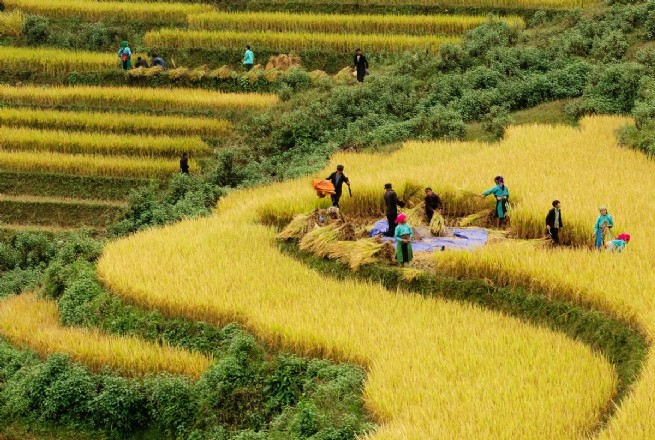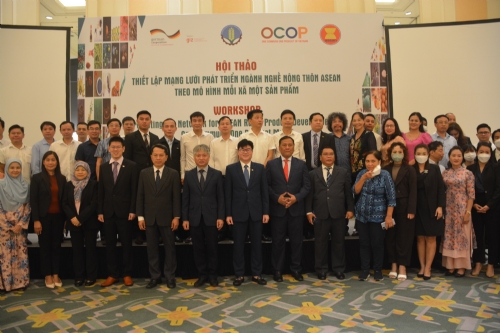Specific Mechanisms Needed for New Countryside Construction in Mountainous Areas
Wednesday, November 13, 2019 15:40

New look for highland
Building new countryside in lowland provinces is already difficult; it is much more difficult to do this in mountainous areas, ethnic minority areas, border communes and places benefiting from Government Program 30a. Due to poor infrastructure and poor people, many localities can hardly achieve new countryside targets. But, in fact, if the entire political system and the people get involved, new countryside is no longer a tough story.
Supported by the Party and the Government, the National Target Program on New Countryside Construction has achieved many important results. Data from the Central Steering Committee for New Countryside showed that 99.4% of communes nationwide have motorways leading to their administrative centers, especially in complex mountainous areas such as Ha Giang, Cao Bang, Yen Bai, Thanh Hoa, Nghe An and Ben Tre. The concreted road system has basically met people’s needs of traveling and transporting goods, thus helping boost consumption of goods and agricultural products, and raise people's incomes.
Up to now, 41.7% of communes in ethnic minority areas and mountainous areas have achieved traffic criteria (when the target program was launched, almost no communes met traffic criteria). Besides, the national power grid covers 100% of communes and 97.8% of villages, with 98.9% in mountainous areas and 99.6% in islands. 90% of communes have fulfilled electricity criteria. Irrigation and water supply systems have been upgraded. 65% of communes have small irrigation systems. 90.7% of communes met No. 3 irrigation criteria. Preschools and schools have been reorganized to meet the demand. 99.7% of communes have primary schools and kindergartens. 60.3% of communes in the country have realized cultural facility criteria and so have 40.3% of communes in ethnic minority areas and mountainous areas.
At the same time, the National Target Program on New Countryside Construction also helps develop production and livelihoods for sustained poverty reduction and increase incomes for people. Agricultural restructuring and new countryside construction have helped many localities in mountainous and poor areas tap their potential advantages to successfully transform some production models linked to value chains and high-tech applications such as Son La, Hoa Binh, Dak Lak, Dak Nong, Lam Dong and An Giang. 15 provinces have approved the list of support projects for value chain-based product development to 2020 as guided by the Ministry of Agriculture and Rural Development. Production forms have been reorganized and adapted to increase efficiency. The household economy has continued to be supported and organized in a larger scale, gradually getting adapted to market mechanisms. In the past two years, cooperatives have increased rapidly in ethnic minority areas and mountainous areas, particularly in Son La province. With all these efforts, up to now, poverty rate in poor ethnic minority areas and mountainous areas has fallen by 3-4% annually.
Need for sustainable development
After 10 years, new countryside construction has clearly differed from region to region. While many localities are speeding up the construction of advanced new countryside models, others are struggling to complete basic criteria for the period of 2016-2020. Given the current reality, it is very, very difficult to keep the current rate of new countryside construction in ethnic minority areas and mountainous areas, let alone make disruptive progress because progress depends on a lot of factors. Apart from large and concentrated financial sources, there must be radical settlement of many other social and welfare issues, such as residential land, productive land, sustainable livelihoods, traditional culture, and ecological environment.
Bottlenecks in new countryside construction in ethnic minority areas and mountainous areas have been analyzed and dissected. Experts strongly proposed the introduction of a specific mechanism for these places to make breakthroughs in this process. Looking back on the 10-year process of the new countryside construction, we managed to dramatically reduce poverty, which is recognized by the international community.
Policymakers agreed on building the National Target Program on Socioeconomic Development in ethnic minority areas and mountainous areas after 2020 to realize the goal of all communes meeting new countryside targets. Given the current rate, it is unlikely for ethnic minority areas and mountainous areas to realize this goal, let alone making disruptive breakthroughs.
Minh Ngoc

 THE PROGRAM COOPERATED WITH CENTRAL COORDINATION FOR NEW-STYLE RURAL
THE PROGRAM COOPERATED WITH CENTRAL COORDINATION FOR NEW-STYLE RURAL
Other news
- HANOI: Promoting the consumption of craft village products and developing community tourism(11/5/2022 3:16:04 PM)
- Chuong My: Effectiveness from the One Commune One Product Program(11/3/2022 10:04:10 AM)
- Thanh Hoa develops OCOP products(11/1/2022 1:30:31 PM)
- Promoting the network for Asia Rural Product Development on one commune one product(8/30/2022 9:43:23 AM)
- Phu Tho eyes 56 new 3-star OCOP products for 2022(8/23/2022 3:09:56 PM)
- Opening of the OCOP product introduction week in Hanoi in 2022 in Phuc Tho district(8/1/2022 3:28:38 PM)
- Evaluation and classification of OCOP products Hoan Kiem District in 2022(7/27/2022 10:10:23 AM)
- Hanoi turns to green, sustainable agricultural sector(6/28/2022 4:10:22 PM)
- OCOP Forum in the Mekong Delta - Dong Thap 2022: Opening up great opportunities for regional products.(5/4/2022 2:38:13 PM)
- Over 1,000 spice products on display in Ho Chi Minh City(4/29/2022 2:34:02 PM)
The featured news
-
HANOI: Promoting the consumption of craft village products and developing community tourism
-
Promoting the network for Asia Rural Product Development on one commune one product
-
Phu Tho eyes 56 new 3-star OCOP products for 2022
-
Opening of the OCOP product introduction week in Hanoi in 2022 in Phuc Tho district
-
Evaluation and classification of OCOP products Hoan Kiem District in 2022






